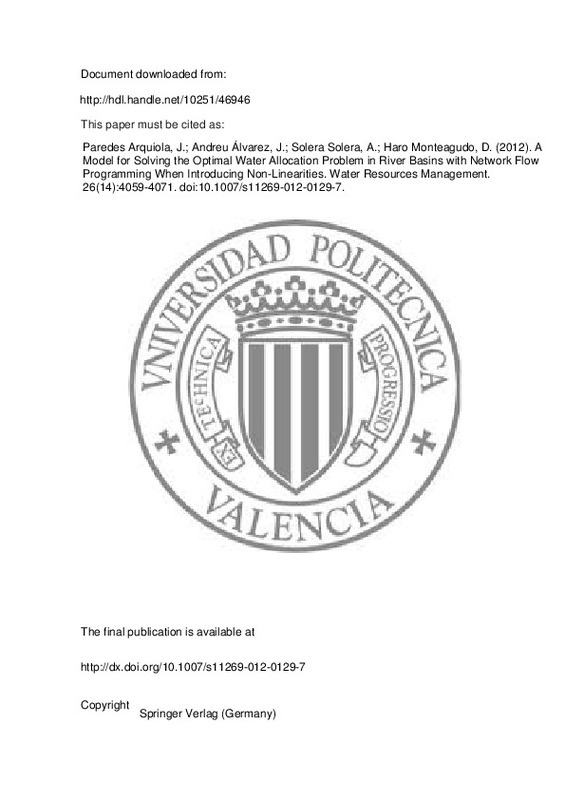Ahuja R, Magnanti T, Orlin J (1993) Network flows: theory, algorithms and applications. Prentice Hall, New York
Andreu J, Capilla J, Sanchís E (1996) AQUATOOL, a generalized decision-support system for water resources planning and operational management. J Hydrol 177:269–291
Bersetkas D (1985) A unified framework for primal-dual methods in minimum cost network flows problems. Math Program 32:125–145
[+]
Ahuja R, Magnanti T, Orlin J (1993) Network flows: theory, algorithms and applications. Prentice Hall, New York
Andreu J, Capilla J, Sanchís E (1996) AQUATOOL, a generalized decision-support system for water resources planning and operational management. J Hydrol 177:269–291
Bersetkas D (1985) A unified framework for primal-dual methods in minimum cost network flows problems. Math Program 32:125–145
Bersetkas D, Tseng P (1988) The relax codes for linear minimum cost network flow problems. Ann Oper Res 13:125–190
Bersetkas D, Tseng P (1994) RELAX-IV: A faster version of the RELAX code for solving minimum cost flow problems. Completion Report under NSFGrant CCR-9103804. Dept. of Electrical Engineering and Computer Science, MIT, Boston
Chou F, Wu C, Lin C (2006) Simulating multi-reservoir operation rules by network flow model. ASCE Conf Proc 212:33
Chung F, Archer M, DeVries J (1989) Network flow algorithm applied to California aqueduct simulation. J Water Resour Plan Manag 115:131–147
Ford L, Fulkerson D (1962) Flows in networks. Princeton University Press, Princeton
Fredericks J, Labadie J, Altenhofen J (1998) Decision support system for conjunctive stream-aquifer management. J Water Resour Plan Manag 124:69–78
Harou JJ, Medellín-Azuara J, Zhu T et al (2010) Economic consequences of optimized water management for a prolonged, severe drought in California. Water Resour Res 46:W05522
Hsu N, Cheng K (2002) Network Flow Optimization Model for Basin-Scale Water Supply Planning. J Water Resour Plan Manag 128:102–112
Ilich N (1993) Improvement of the return flow allocation in the Water Resources Management Model of Alberta Environment. Can J Civ Eng 20:613–621
Ilich N (2009) Limitations of network flow algorithms in river basin modeling. J Water Resour Plan Manag 135:48–55
Kennington JL, Helgason RV (1980) Algorithms for network programming. John Wiley and Sons, New York
Khaliquzzaman, Chander S (1997) Network flow programming model for multireservoir sizing. J Water Resour Plan Manag 123:15–21
Kuczera G (1989) Fast Multireservoir Mulltiperiod Linear Programming Models. Water Resour Res 25:169–176
Kuczera G (1993) Network linear programming codes for water-supply headworks modeling. J Water Resour Plan Manag 119:412–417
Labadie J (2004) Optimal operation of multireservoir systems: state-of-the-art review. J Water Resour Plan Manag 130:93–111
Labadie J (2006) MODSIM: river basin management decision support system. In: Singh W, Frevert D (eds) Watershed models. CRC, Boca Raton, pp 569–592
Labadie J, Baldo M, Larson R (2000) MODSIM: decision support system for river basin management. Documentation and user manual. Dept. Of Civil Engineering, CSU, Fort Collins
Manca A, Sechi G, Zuddas P (2010) Water supply network optimisation using equal flow algorithms. Water Resour Manag 24:3665–3678
MMA (2000) Libro blanco del agua en España. Ministerio de Medio Ambiente, Secretaría general Técnica, Centro de Publicaciones
MMA (2008) Confederación Hidrográfica del Duero. Memoria 2008. http://www.chduero.es/Inicio/Publicaciones/tabid/159/Default.aspx . Last accessed 25 June 2012
Perera B, James B, Kularathna M (2005) computer software tool REALM for sustainable water allocation and management. J Environ Manag 77:291–300
Rani D, Moreira M (2010) Simulation-optimization modeling: a survey and potential application in reservoir systems operation. Water Resour Manag 24:1107–1138
Reca J, Roldán J, Alcaide M, López R, Camacho E (2001a) Optimisation model for water allocation in deficit irrigation systems I. Description of the model. Agric Water Manag 48:103–116
Reca J, Roldán J, Alcaide M, López R, Camacho E (2001b) Optimisation model for water allocation in deficit irrigation systems II. Application to the Bembézar irrigation system. Agric Water Manag 48:117–132
Sechi G, Zuddas P (2008) Multiperiod hypergraph models for water systems optimization. Water Resour Manag 22:307–320
Sun H, Yeh W, Hsu N, Louie P (1995) Generalized network algorithm for water-supply-system optimization. J Water Resour Plan Manag 121:392–398
Wurbs R (1993) Reservoir-system simulation and optimization models. J Water Resour Plan Manag 119:455–472
Wurbs R (2005) Modeling river/reservoir system management, water allocation, and supply reliability. J Hydrol 300:100–113
Yamout G, El-Fadel M (2005) An optimization approach for multi-sectoral water supply management in the greater Beirut area. Water Resour Manag 19:791–812
Yates D, Sieber J, Purkey D, Hubert-Lee A (2005) WEAP21 – a demand-, priority-, and preference-driven water planning model. Part 1: model characteristics. Water Int 30:487–500
Zoltay V, Vogel R, Kirshen P, Westphal K (2010) Integrated watershed management modeling: generic optimization model applied to the Ipswich river basin. J Water Resour Plan Manag 136:566–575
[-]







![[Cerrado]](/themes/UPV/images/candado.png)


